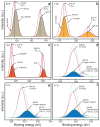Harnessing BiOI/V2O5 Nanocomposites: Advanced Bifunctional Catalysts for Visible-Light Driven Environmental Remediation and Antibacterial Activity
- PMID: 40572466
- PMCID: PMC12196363
- DOI: 10.3390/molecules30122500
Harnessing BiOI/V2O5 Nanocomposites: Advanced Bifunctional Catalysts for Visible-Light Driven Environmental Remediation and Antibacterial Activity
Abstract
Efficient photocatalysts based on composite materials are essential for addressing environmental pollution and enhancing water purification. This study presents a novel BiOI/V2O5 nanocomposite (BVNC) with a flower-like layered structure, synthesized via a low-temperature solvothermal process followed by high-pressure annealing for visible light (VL)-driven dye degradation and antibacterial activities. Compared to individual BiOI nanoparticles (BOINP) and V2O5 nanoparticles (VONP), under VL, the BVNC demonstrated significantly enhanced photocatalytic and antibacterial activity. The best-performing BVNC achieved a remarkable methylene blue degradation efficiency of 95.7% within 140 min, with a rate constant value 439% and 430% of those of BOINP and VONP, respectively. Additionally, BVNC exhibited high photocatalytic efficiencies for rhodamine 6G (94.0%), methyl orange (90.4%), and bisphenol A (69.5%) over 160 min, highlighting the superior performance of the composite materials for cationic and anionic dyes. Furthermore, BVNC established outstanding antibacterial capability against Staphylococcus aureus and Escherichia coli, demonstrating zones of inhibition of 12.24 and 11.62 mm, respectively. The improved catalytic and antibacterial capability is ascribed to the presence of a robust p-n heterojunction between BOINP and VONP, which broadens the photo-absorption range, reduces bandgap energy, and facilitates the significant separation of excitons and faster release of reactive oxygen species.
Keywords: BiOI/V2O5 composite; antibacterial activity; p-n heterojunction; visible-light-driven photocatalysts; wastewater treatment.
Conflict of interest statement
The authors declare no conflict of interest.
Figures











Similar articles
-
Visible-Light-Driven Co3O4/Nb2O5 Heterojunction Nanocomposites for Efficient Photocatalytic and Antimicrobial Performance in Wastewater Treatment.Molecules. 2025 Jun 12;30(12):2561. doi: 10.3390/molecules30122561. Molecules. 2025. PMID: 40572526 Free PMC article.
-
Illuminating the Power of V2O5 Nanoparticles: Efficient Photocatalytic Degradation of Organic Dyes under Visible Light.J Fluoresc. 2025 Jun;35(6):4335-4345. doi: 10.1007/s10895-024-03841-3. Epub 2024 Jul 13. J Fluoresc. 2025. PMID: 39002052
-
Heterojunction configuration-specific photocatalytic degradation of methyl orange and methylene blue dyes using ZnO-based nanocomposites.J Adv Res. 2025 Jun 10:S2090-1232(25)00436-9. doi: 10.1016/j.jare.2025.06.027. Online ahead of print. J Adv Res. 2025. PMID: 40505958
-
Structural regulation and photocatalytic antibacterial performance of TiO2, carbon dots and their nanocomposites: a review.J Colloid Interface Sci. 2025 Dec 15;700(Pt 2):138482. doi: 10.1016/j.jcis.2025.138482. Epub 2025 Jul 23. J Colloid Interface Sci. 2025. PMID: 40716222 Review.
-
Metal ferrites-based nanocomposites and nanohybrids for photocatalytic water treatment and electrocatalytic water splitting.Chemosphere. 2023 Jan;310:136835. doi: 10.1016/j.chemosphere.2022.136835. Epub 2022 Oct 12. Chemosphere. 2023. PMID: 36243091 Review.
References
-
- Gyawali N., Lee I., Shrestha S., Acharya S., Zahid A., Kim K., Sapkota K.P., Hahn J.R. MOF-derived in situ confinement of copper/copper oxide nanoparticles inside a carbon tube: A facile morphologically controlled synthesis strategy for superior visible-light-driven photocatalytic efficiency. Ind. Eng. Chem. Res. 2025;64:5212–5227. doi: 10.1021/acs.iecr.4c03977. - DOI
-
- Kishor R., Purchase D., Saratale G.D., Saratale R.G., Ferreira L.F.R., Bilal M., Chandra R., Bharagava R.N. Ecotoxicological and health concerns of persistent coloring pollutants of textile industry wastewater and treatment approaches for environmental safety. J. Environ. Chem. Eng. 2021;9:105012. doi: 10.1016/j.jece.2020.105012. - DOI
-
- Tan K.A., Morad N., Ooi J.Q. Phytoremediation of methylene blue and methyl orange using Eichhornia crassipes. Int. J. Environ. Sci. Dev. 2016;7:724–728. doi: 10.18178/ijesd.2016.7.10.869. - DOI
-
- Nashim A., Parida K. Novel Sm2Ti2O7/SmCrO3 heterojunction based composite photocatalyst for degradation of Rhodamine 6G dye. Chem. Eng. J. 2013;215–216:608–615. doi: 10.1016/j.cej.2012.11.025. - DOI
-
- Moussavi G., Pourakbar M., Shekoohiyan S., Satari M. The photochemical decomposition and detoxification of bisphenol A in the VUV/H2O2 process: Degradation, mineralization, and cytotoxicity assessment. Chem. Eng. J. 2018;331:755–764. doi: 10.1016/j.cej.2017.09.009. - DOI
MeSH terms
Substances
Grants and funding
LinkOut - more resources
Full Text Sources
Medical

